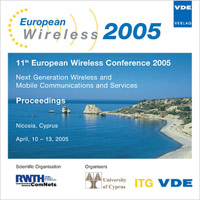Connection Admission Control in UMTS with respect to Network Capacity and Quality of Service
Konferenz: European Wireless 2005 - 11th European Wireless Conference 2005 - Next Generation wireless and Mobile Communications and Services
10.04.2006 - 13.04.2005 in Nicosia, Cyprus
Tagungsband: European Wireless 2005
Seiten: 7Sprache: EnglischTyp: PDF
Persönliche VDE-Mitglieder erhalten auf diesen Artikel 10% Rabatt
Autoren:
Malkowski, Matthias; Schnick, Michael; Schinnenburg, Marc (Communication Networks, Aachen University, Kopernikusstr. 16, 52074 Aachen, Germany)
Schmocker, Michael (Swisscom Mobile AG, Belpstr. 48, 3007 Bern, Switzerland)
Inhalt:
The increasing number of subscribers in third generation networks, such as UMTS, will push these networks to their capacity limits within the next years. Especially UMTS tends to become instable when operated close to the capacity limit. Therefore, to meet the subscribers’ QoS requirements andmaximize the operators’ profit, a thoroughly parameterized Connection Admission Control (CAC) is indispensable in order to keep the system in a stable state. In this paper, we analyze existing CAC strategies. Furthermore, we offer new strategies to enhance the system’s capacity without endangering network stability. This is of great interest for each UMTS network operator since a better CAC algorithm allows a higher network capacity without any additional hardware installation costs. For this investigation a new simulation platform to evaluate the performance of mobile radio networks at a very detailed level has been designed and implemented. A UMTS Radio Interface Simulator (URIS), which emulates the standardized UMTS protocol stack and the TCP/IP protocol suite, is used together with a Radio Interference Simulation Engine (RISE), which is in charge of calculating the inter- and intra-cell interference, to evaluate the performance of the CAC.


